#Betty Anne Rees
Explore tagged Tumblr posts
Text

The Deathmaster, US lobby card #4. 1972
6 notes
·
View notes
Text

Betty Anne Rees and Bill Ewing in Deathmaster (1972)
24 notes
·
View notes
Text

‘Unholy Rollers’ And ‘Sugar Hill’ Star Betty Anne Rees Dies At 81
https://movies.mxdwn.com/news/unholy-rollers-and-sugar-hill-star-betty-anne-rees-dies-at-81/
0 notes
Text

Betty Anne Rees, ‘The Unholy Rollers,’ ‘Sugar Hill’ actress, dead at 81 http://dlvr.it/T82Sss
0 notes
Photo

Films Watched in 2019:
94. Sugar Hill (1974) - Dir. Paul Maslansky
#Sugar Hill#Paul Maslansky#Marki Bey#Robert Quarry#Don Pedro Colley#Betty Anne Rees#Richard Lawson#Zara Cully#Charles Robinson#blaxploitation#Films Watched in 2019#My Post
4 notes
·
View notes
Photo

Bad movie I have Sugar Hill 1974
#Sugar Hill#American International Pictures#Marki Bey#Robert Quarry#Don Pedro Colley#Betty Anne Rees#Richard Lawson#Zara Cully#Charles Robinson#Larry Don Johnson#Rick Hagood#Ed Geldart#Albert J. Baker#Raymond E. Simpson#Truman C. Carroll#'Big Walter' Price#Charles Krohn#J. Randall Bell#Tony Brubaker#Peter Harrell#Judy Hanson#Gary Chason#Roy L. Downey#Garrett Scales#John Scarborough
6 notes
·
View notes
Text

#sugar hill#horror movie#black horror#zombies#marki bey#betty ann rees#robert quarry#don pedro colley#larry d johnson#richard lawson#zara cully
2 notes
·
View notes
Text
Stacking the Shelves #5
Stacking the Shelves #5
Stacking the Shelves is hosted by Tynga’s reviews and you can find the original post here, for more details and guidelines. Stacking The Shelves is all about sharing the books you are adding to your shelves, may it be physical or virtual. This means you can include books you buy in physical store or online, books you borrow from friends or the library, review books, gifts and of course…

View On WordPress
#anne marie garat#audrey niffenegger#betty#book haul#booksellers#cat#dolly alderton#donal ray pollock#donna tartt#edouard louis#gareth e rees#haul#Hilary mantel#indies#influx press#it#jean cocteau#kate reed petty#les enfants terribles#marie despechin#marshland#pet sematary#photography#qui a tue mon pere#stephen graham jones#Stephen king#susan hill#the apparition phase#the devil all the time#the little friend
4 notes
·
View notes
Photo
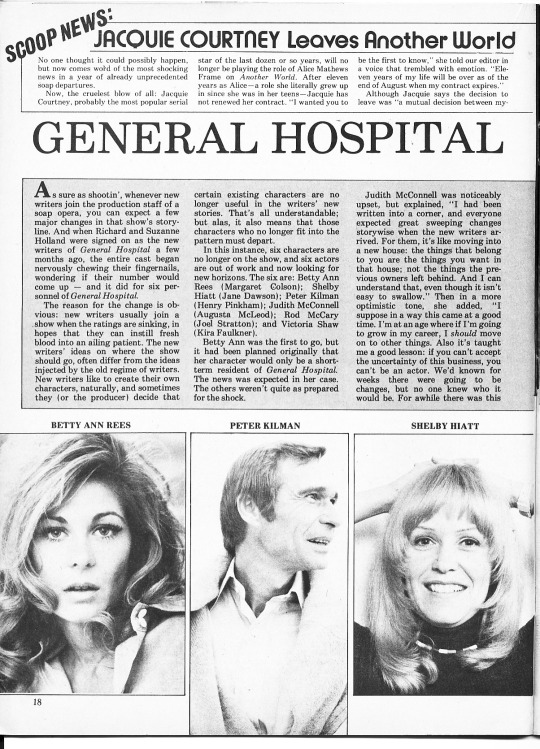
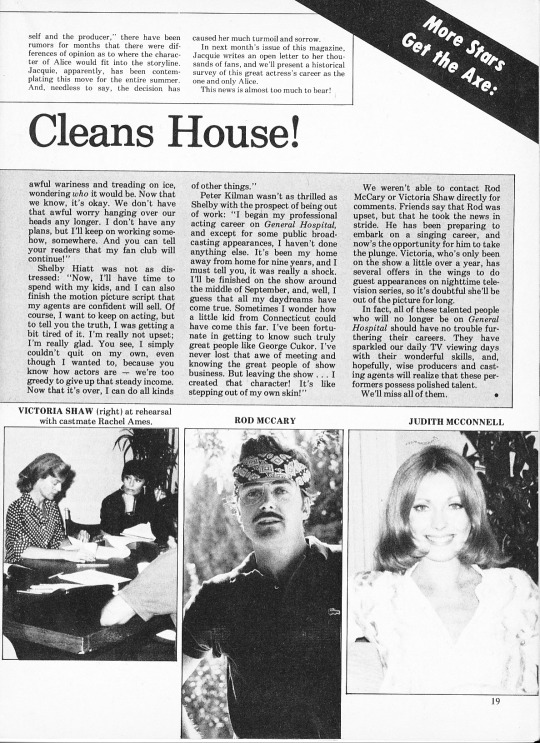
Daily TV Serials - November 1975 - General Hospital Cleans House
#daily tv serials#daily tv serials november 1975#general hospital#judith mcconnell#rod mccary#victoria shaw#shelby hiatt#betty ann rees#Peter Kilman
14 notes
·
View notes
Text

The Deathmaster, US lobby card #6. 1972
2 notes
·
View notes
Text
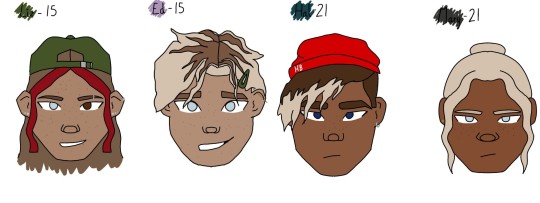
GENERAL HEADCANONS
•Mary is a Catholic bi girl
•Edward is gay and didn't realize until Liz just straight up told them.
•Edward goes by He/Them pronouns
•Henry goes by either Hal,Fitz or Roy
•DO NOT call him Henry.
•Also gay but knew and accepted himself the easiest with that.
•Mary Queen of Scots goes by the names of Scots,Stuart,Maria & Ree.
•Her son James gets reincarted when she's 25.
•Eventhough this time around she doesn't have to she still declares Elizabeth as his godmother something, Bess pretended not to cry at.
•Jane Grey goes by Janie or Grey (really only Elizabeth calls her Grey as a joke tho).
•Janie is pansexual and uses she/they pronouns.
•To Mary's dismay, Elizabeth is more chaotic than Anne if that is even possible.
•Elizabeth has many nicknames consistin of ,Eliza, Liza, Liz, Lizzie, Beth, Bess, Bessie, Eli, Betsey, Betty, Lisbeth or Lisbet (only by Anne for that that one) or all of them if your Edward trying to get her attention.
•Elizabeth is now known as the biggest flirt (when she not committed to Robert Dudley of course) because she veiws it as a little F U to her father that killed her mother on behalf of those reasons.
•This time it's much to Fitz and Ed's dismay.
•Elizabeth always forces Edward to letting her his nails and make-up (they secretly enjoy & Bess knows that he does). Sometimes she does Hal's nails too
•Mary become the least proctective of Liz purely because she realised how much worse it was for her now that Anne & Hal & Edward & Scots & even sometimes Jane Seymour or Anna Von Kleves are with coddling or protecting her.
•Mary Seymour only goes by Mae it's such a big thing Cathy is just considering changing her name to that legally.
•Mae is the youngest in the queen's(+ a king) household.
•To everyone surprise Mary is actually better at babysitting her than Elizabeth while Edward is just being her supportive cousin on the side.
•Their heights go Hal:5'10 Mary:5'8 Maria:5'8 Edward:5'6 1/2 Elizabeth 5'4 Janie:4'10 (small bean).
•Their ages go Mary:21 Hal:21 Elizabeth:15 Edward:15 Maria:15 Janie:14
SOON/AFTER REINCARNATION
•Fitzroy was reincarnated about 5 years before the rest of the Tudor siblings were because his mum works with the reincarnation company.
•Anna was the one to open the door when Mary, Elizabeth, Edward & Mae woke up outside the house and the first thing she did was yell back to the queen's sitting anxiously inside the living room "I have one hell of surprise for you guys!".
•After a short-lived staring contest between Anna & Mary, the kids (well only one toddler really and two teengers + a 20 year old) were escorted to shocked faces sat on a sofa.
•Edward & Mary did not instantly go to mothers but instead opt to death stare Cathy until Liz slapped them round the back of their heads as a way to say stop.
•After Anne embracing her and sobbing for ten minutes, Bess simply got bored step back from her, look down at her hands and go "Holy Shit, I'm young!!!" and proceed to run around like a headless chicken continually shouting at the top of her lungs " I'M NOT SIXTY" " Mary,MARY,LOOK!!"
•It took a couple of weeks with a lot of convincing of Bess to stop Edward from wanting to murder Cathy every time he saw her.
•Edward might be the youngest but don't get wrong Elizabeth is the baby of the family.
•When Mary came out as bi to her Catalina, Elizabeth & Anna went all protective mode in that conversation
•This later became the reason why Mary didnt go out of her way threaten Robert whe he started dating Bess, as a little but meaningful thank you to her for her support.
TUDOR FAMILY
•At some point in the future Scots' son (James) is reincarnated.
•Elizabeth is once again his godmother but this time it's not a bribe.
•Because Bess babysat James so much Mary asked why,, as she usually wasn't to keen on baby no matter what relation, she answered to it with a calm response of "James is my GODSON, I am his GODMOTHER, this child makes a God by name, of course I will protect him with my life"
•They both hate to admit but our both (especially scots) protective of eachother, with Bess denying something that's true and Mary just using an excuse like "If someone is going to cause Elizabeth bodily harm it's going to be me".
BESS AND THE DUDLEY'S
•When the Dudley's get reincarnated (John now as a better person) she (and Janie) are accepted as part of the family, with Bess being Mary (Mars) Dudley's best friend, Roberts kinda girlfriend depending ont the day(wife in everyway apart from legally), Guildford's chaotic partner-in- crime and John's golden child (even if it's not legal)
•Liz & Mars' friendship is basically them bitching about people they don't like and/or disgust them, daring eachother to do dumb shit and Mary pretending Elizabeth isn't making out with her brother in their school corridors.
•Elizabeth & Guildford Dudley go further than the rest of Bess's siblings and cousins in calling him there cousin-in-law by calling eachother 'My practically brother/sister in law' to the point everyone refers to the two them like that.
•One day Robert goes up to Liz and asks if she considers them 'practically married',she of course denied it (once again tho it was true) but they both ( and everyone else for that matter) know it's the reason behind her & Guildford's nicknames.
•To any encanto and spop fans Robert Dudley & Elizabeth is literally just Pepa & Felix + Mermista & Seahawk rolled into one.
•The queen's + kid's household now just expect to see Ed rolling after school looking exhausted and judgemental at the fact right behind him Elizabeth is storming inside with an apologetic Robert behind her. Sometimes Mars is there too taking pictures of her distressed brother.
•During the many off stages of their on & off relationship Robert has acquired many things thrown at him while they've been breaking up. Consisting of an egg Elizabeth for some reason had in her bedroom, hairdryer, hair straightener etc.,etc.,many,many shoes + hats, the two miny pride flags she has in honour of Edward & Mary ( gay for Ed, bi for Mary), a lot of makeup bags, a few pillows, and a couple of hairbrushes, + more ( at separate dates to be clear, this wasn't all at one of their break ups).
•The Duldeys mainly call Elizabeth Eliza out of habit because in their past life they remembered how she cringed when saying her full name because it was a reminder that as the king's daughter she could never relax in a place that wasn't her household.
•John Dudley considers Elizabeth his daughter and has at many points in time invited her out to a coffee shop even when her and Robert weren't in their realtionship.
•Lizzie has always considered John a father figure.
FAMILY DYNAMICS
•To start it of we have Bess & Eddie who have the closest bond within the siblings due to there now only being a 33 day age difference between them. Plus their both in most of eachothers classes in school.
•Then we have Mary and Hal their relationship is complicated, always has been, always will, but they do occasionally bond on being the oldest of the reincarnated Tudors and obviously their bat-shit crazy siblings.
•Mary & Bess are probably the pair that are the second closest to eachother. It's more of advice giving bond they have, mainly because Mary's still trying to make up for the past and Elizabeth doesn't trust her mum to not go mental with some of the stuff she needs help with.
•With Mary and Edward it's quite awkward with how they nether saw eye to eye in the past. But Mary will still do anything for them because of gravely she missed them when he died.
•Edward and Hal really only occasionally roll their eyes to eachother whe their sisters are being dramatic (acting like their not).
•Roy still has a hard getting over the fact the Bess is a teenager and not the 3 year old girl who could barely reach his knee, but height dilemmas aside, their quite close and always tease eachother. Roy always beats everyone else in being Elizabeths biggest supporter
• Mary nor Hal are particularly closes to their cousins and usually stick together when the have their family reunions.
•They both might die keeping it a secret, but with as much agression they display towards one another Ree & Lizzie have one of the most heart warming friendship you will ever see.
• Janie and Eddie are eachothers best friends and are referred to as the little sunshine's of the family.
And no I don't take criticism
#six the kids#robert dudley#mary i of england#elizabeth i#edward vi#mary queen of scots#lady jane grey#anne boleyn#catherine parr#catherine of aragon#anna of cleves#jane seymour#henry fitzroy
36 notes
·
View notes
Photo

"Sugar Hill" (1974) is a Black cult horror film that gives you all that goods for entertainment. The 1970s saw a surge in Black horror films, a genre that didn't see many productions for decades. Like, many Black horror films during this era, the central theme for "Sugar Hill" was voodoo and zombies. The actors in this film are great, and I absolutely dig the theme song "Supernatural Voodoo Woman" by The Originals. #blackhorrormovies Director: Paul Maslansky Writer: Tim Kelly Starring Marki Bey, Don Pedro Colley, Richard Lawson, Zara Cully, Charles Robinson, Betty Anne Rees, Larry Don Johnson, Rick Hagood Storyline When her boyfriend is murdered by gangsters, Sugar Hill decides not to get mad, but BAD! She entreats voodoo queen Mama Maitresse to call on Baron Samedi, Lord of the Dead, for help with a gruesome revenge. In exchange for Sugar's soul, the Dark Master raises a zombie army to do her bidding. Unfortunately, the bad guys who think they got away clean are about to find out that they're DEAD wrong. https://www.daarac.ngo https://www.daaracarchive.org/2008/09/sugar-hill-1974.html
2 notes
·
View notes
Text
Here Lies Jenny: Bebe Neuwirth’s under-remembered masterpiece?
While Bebe Neuwirth is often remembered foremost for her presence in worlds like Chicago, Cheers or Fosse, there’s another piece in the tapestry of her work that brings many notable threads together and is equally significant to her.
Here Lies Jenny is the somewhat under-discussed piece of theatre that in fact has connections to all three of these aforementioned things, because of the people she worked herself on creating it with, and deserves to be brought up with slightly more comparable frequency.
A moment then to explore some of the history of this elusive but important show.
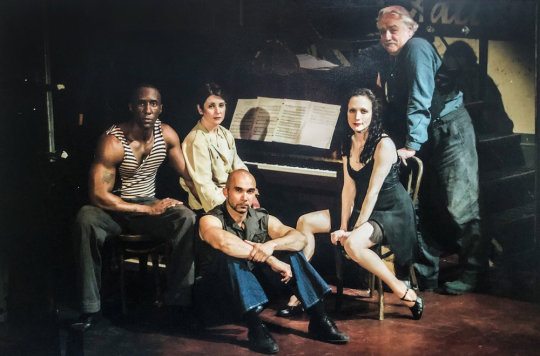
Here Lies Jenny, recalled as a “surprise off Broadway hit”, opened at the Zipper Theatre in downtown Manhattan in May 2004 and ran there for five months.
The show was an interpretive revue of the music of German composer, Kurt Weill, born out of an idea Bebe had herself. It was shaped by collaboration with close friends – with its initial genesis assisted by Leslie Stifelman (the show’s pianist, who she’d worked with on Chicago), direction by Roger Rees (who she’d long known and worked with since their time on Cheers together), and choreography by Ann Reinking (who was Bebe’s closest dance companion in the Fosse universe).
Set in a dark and shadowy looking barroom, the piece followed Bebe as the central, amorphous female figure named ‘Jenny’, supported by three male cast members and a pianist, through an evening of carefully selected Weill songs. Alongside Bebe and Leslie on stage were Gregory Butler and Shawn Emamjomeh, as two rough denizens of the bar, and Ed Dixon as the general proprietor.
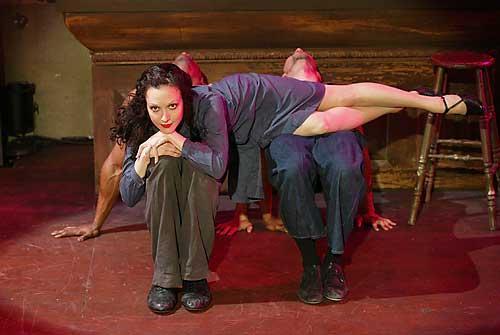
There was no linear storyline to the show and no spoken dialogue, but Bebe described how the evening unfolded “in a very logical and emotional, fulfilling way.” All of the songs presented “[described] the interaction between these five people there, that make it necessary to sing the next song.” Rather than taking a group of songs by a particular composer and imposing a narrative on them, the songs were interwoven together to create an “impressionistic and realistic painting of this person’s life.”
To give a summary of the show’s arc, Jenny initially descends the wire staircase into the bar, with little more than a frightened expression and a small bag of wordly possessions. Accosted by the two forceful patrons, she’s flattened down both physically and emotionally. The men depart and return throughout, and the emotional core of the piece fluctuates from song to song as each number evokes a different picture and interpretation of a circumstance or feeling. As reviewers put it, “she’s sometimes bold, sometimes reticent, until she leaves…with what seems like a modicum of self-possession and hope,” and “climbs that long staircase on her way into the world again.”

The idea for creating Here Lies Jenny came out of Bebe’s own desire to put together a piece of theatre and an evening of performance of her own. It was a notion intensified by growing external interest, or as she recalled, “people have always said to me ‘Do a show, do a show, do a one woman show!’”
But for a while the form the piece would take was unclear. Bebe knew she “didn’t want to do a revue”, and she didn’t want “the usual cabaret thing… [or] ‘Bebe and Her Boys.’”
“I generally hate one women shows,” she would remark, “unless it’s Elaine Stritch or Chita Rivera or, you know, Patti LuPone.”
According to Bebe, she’s “much more comfortable as a character doing something. I'm not comfortable just being myself and singing in front of people.”
On and off for around two and a half years then, Bebe had been considering how to approach this matter while putting together some music, predominantly that of Kurt Weill, with musician, conductor and friend from Chicago, Leslie Stifelman.
Leslie suggested bringing in a director, so Bebe turned to Roger Rees – a person she regards as “not just a great actor,” but also “a fantastic director”, with a “very interesting creative mind.” Showing Roger the songs, he “realised that they all described women, or aspects of women, or different times in women’s lives.”
Roger thought it would be interesting then to combine all of these varied sentiments and have them channelled through one specific woman, in one specific location, to present a complex but diversely applicable tapestry centred around the emotional interiority of one tangible female force.
The show is “fragmented, prismatic…less narrative than poetic,” according to Roger. It’s not prescriptive. Rather, it evokes strong feelings and allows the audience to interpret them into their own individual and personal narrative for this woman. It poses questions and provokes thoughts. Who is this woman? Why is she here? Why is she here now? Is that a child? Or is that just a wish for a child? What did she have in this life before we meet her and what has she now lost?
It is indeed an unusual entity, and atypical from other more standard revues, cabaret acts, or works of theatre. A “self-described Japanophile”, Bebe explained how it played in the “Japanese aesthetic concept known as wabi sabi.” Of this she would elaborate, “There’s no direct translation, but it’s about the beauty of things as they age, embracing what’s painful in life as well as what’s joyful.”
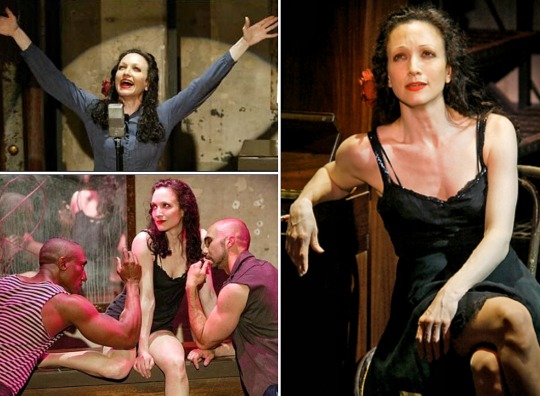
It is certainly a piece that contains beauty as well as pain, which itself is a complexity and dichotomy often ascribed to Kurt Weill’s music.
When initially finding and working on songs for what was to become Here Lies Jenny, Bebe noticed being drawn to the work of one composer most strongly.
Like Bernadette Peters talking about how she gravitates to selecting Stephen Sondheim’s material for her concerts, Bebe would say simply, “all of the music that I loved the most was Kurt Weill music.”
A revue in 1991 called Cabaret Verboten (also with Roger Rees), that sought to recreate a Weimar Republic cabaret and re-conjure some of the decadence of pre-Nazi Germany, increased Bebe’s exposure to Kurt Weill’s music and was where she “first became captivated by the composer”. Building on this strong connection and deep appreciation in the years since then, Bebe would assert of his music, “it resonates for me.”
“Neuwirth knows Weill’s music isn’t for everyone,” one reviewer wrote, “but she won’t apologize for it.” She sees its capacity to be “appreciated on many different levels,” and has described it on varying occasions as “unflinchingly honest”, “very fulfilling to perform”, not just “arch and angular and Germanic…[as] many people think”, but as having “great lyricism and tenderness”.
Bebe feels a strong affinity for Weill’s music in part because of its “ability to convey the truth completely and fearlessly and without artifice”. For example, “If you're talking about heartbreak, [his music] goes to the absolute nth degree of what that really means. The way he shows that is with fearless lyrics and the bravery to make the music as beautiful as it can be.”
“Maybe the way I appreciate it speaks to the kind of person I am,” she would say. “I’m very bright but not an intellectual. I like things in a visceral, passionate and spiritual way.” And to Bebe, Weill’s music certainly provides that – which was why devising this show was of such importance and significance to her.
Bebe said also that “the show offers the broad range of Weill's songwriting talents.” This is indeed a truism, with the work of no fewer than ten different lyrists being showcased across the nearly two dozen songs during the evening, including Berthold Brecht, Ira Gershwin, Alan Jay Lerner, Langston Hughes, and Ogden Nash.
The different styles and languages of Kurt Weill’s music mirror Weill’s own history and geographic progression through the world. Born in Germany, “Weill, a Jew, had to flee the Nazis at the height of his popularity. He fled to France and then to the United States, where he became a citizen in 1943.”
His songs reflect the world in which he was living. For instance, ‘The Bilbao Song’ is a tale of sometimes gleeful, sometimes regretful nostalgia and comes from a collaboration with Berthold Brecht in German. It is performed here only in English through the use of “Michael Feingold's now-accepted translation”. The Brechtian-ism is a feature of this production as a whole that was remarked on at the time, being appraised there was “more than a dash of an alienation effect at play,” with material being sung for example behind grilled windows or facing away from the audience.
His French material is alternately reflective of the musical identity Weill tried to devise while having to reinvent himself from scratch in France. Bebe performs one of these French numbers here, entitled ‘Je ne t'aime pas’, which has its own poetic lyricism, and indeed mournful significance, given the translation of the title as ‘I don’t love you’.
Alternately, jazzy, Broadway glamour is comparatively evident in some songs like ‘The Saga of Jenny’ from musicals that arose in America on the Great White Way out of the era of Golden Age of the American musical in the ‘40s to the 60’s.
This show was ambitious then, in its mission of exploring a wide range of the composer’s musical contributions across multiple decades, countries, styles of music, and lyrical collaborations.

Beyond his own musicals, Kurt Weill’s music has been notably seen elsewhere on Broadway or in the theatre world via interpretations such as songs in concerts with Betty Buckley, Patti LuPone, Ute Lemper; or full stage productions with Donna Murphy as Lotte Lenya in Hal Prince’s 2007 Lovemusik; or Lenya’s recordings herself.
Much of Kurt Weill’s legacy lives on through his wife, Lotte Lenya, who was seen as his “chief interpreter… [and] largely responsible for reviving interest in the composer” after his death.
Like Lotte with her “whisky baritone”, Bebe is able to convey meaningful interpretations of Weill’s music through her vocal richness and skilled acting choices, carefully controlling factors like timing, pronunciation and syllabic stress.
An example. Bebe does the most satisfying version of ‘The Bilbao Song’ I have heard. There’s a line in this song that states: “Four guys from ‘frisco came with sacks of gold dust,” in which the last portion of the phrase is repeated a further two times. Bebe emphasises the third “SACKS, of gold dust?!” in the dramatic manner stylised through my punctuation in attempts at recreating its phonology, which contrasts against the two previous readings. This gives the line a salient narrative purpose. It conveys not just an observation, but a tale of surprise and incredulity – who on earth would walk into a bar carrying entire sacks of gold dust?
It may be seemingly just one small detail, but it has a large impact. Other versions that intonate all three repetitions of this line the same miss this engaging variation and feel flat in comparison.
This song would justly so later become a staple of her concert material – along with others like ‘Surabaya Johnny’ and ‘Susan’s Dream’.
But there is unfamiliar territory traversed in Here Lies Jenny too. The rendition of Ogden Nash’s lyrics with ‘I'm a Stranger Here Myself’ is ‘new’ – and it’s exquisite, in its melodic, lilting and playful but darkly seductive swirling sentiment.
Another notable number in need of individual mention would be ‘The Saga of Jenny’. There are two Kurt Weill songs most strongly associated with the ‘Jenny’ moniker – this, and the also well-known ‘Pirate Jenny’ from The Threepenny Opera, which Bebe had done a production of in 1999. The latter was trialled in early versions of the show but ultimately didn’t “serve the piece as well as other…moments could,” so was taken out. Fortunately, Bebe would later work it into her concerts.
The former made it in, and provides the exciting opportunity to get to hear Bebe’s take on this song as made well-known by a number of respected performers. ‘The Saga of Jenny’ appeared initially in Weill & Gershwin’s collaboration for the musical Lady in the Dark in 1941, starring Gertrude Lawrence. The song has since gone through innumerable reiterations, such as via Ginger Rogers in the 1944 film adaptation of the same name; Julie Andrews’ big-production performance in the Gertrude Lawrence biopic Star! in 1968; and other high-profile concert performances like via Ruthie Henshall, Christine Ebersole, Lynn Redgrave and Ute Lemper; along with Lotte Lenya’s own recordings.
Further extending the song’s life was ‘The Saga of Lenny’ – a version devised with new lyrics by Stephen Sondheim, performed by Lauren Bacall for Leonard Bernstein’s 70th Birthday in 1988. All of these are on YouTube and I would testify are worth a watch.
In this show, Bebe performs the number with the bravado of a war-time songbird. She strides around with an old-school 1940s microphone back and forth across the stage as she progresses through the song’s distinct chronological sections, grounding the show centrally back to its identifying moniker and characterising an eponymous, engaging and multiply varied ‘Jenny’.
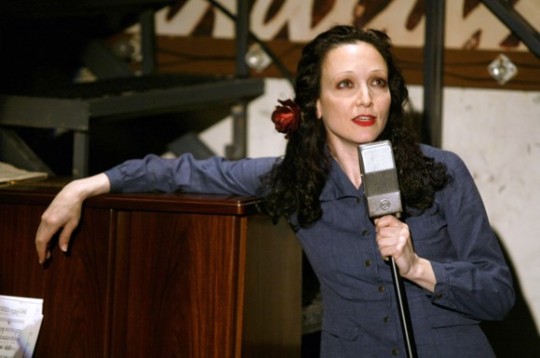
When not bound to microphones, Here Lies Jenny also involved the use of Ann Reinking’s “minimal but inventive” choreography to create striking visual images. Though perhaps not resembling the fast-paced, razzle-dazzle of Chicago, these patterns of movement are at times no less impactful. Bebe is dragged fluidly across a countertop, rolled sinuously down pairs of legs, centred in a dark tango (that one review likened as a potential metaphor for a ménage à trois), or spun backwards upside down onto Emamjomeh’s shoulder in the air – to name a few notable moments.
Not a dance show by any strict sense, all of these demands are nonetheless physically taxing. This is a matter of importance given the timing of the show.
What Bebe had long deemed a “peculiar” hip from her early twenties, begun causing notable pain when it “went from peculiar to downright bad in 2001” during Fosse on Broadway. It was recorded the “pain continued during [this] high-concept Kurt Weill revue” in 2004, such that performing this manner of movement in the show can have been no trivial feat. The next three years brought subsequent arthroscopic surgery for cartilage removal, and then total hip replacement.
That being considered, the show was able to run in the highly demanding manner it did for five months straight because of Ann Reinking’s assiduously crafted choreography.
The Zipper Theatre was the “funky downtown Manhattan space” that housed the show for that time. The timing of the production and the nature of the theatre played integral parts in the piece’s characterisation.
Roger took Bebe to see the theatre when they were devising the show, and to Bebe, it felt right. “There is this creative gesture that we are making and the gesture is completed if it’s in this place.” Not in some new, shiny theatre; but here, with a darkness and sense of history that created an evocative mood similar to the tone of the whole show “as soon as you walked into the building.” This was aided by the show beginning at 11pm each night – “absolutely an artistic choice” – given that what “happens between these five people, happens very late at night”, in a shadowy time of day filled by darkness and secrets.

Here Lies Jenny ended its run in New York in October 2004. But this did not mark the end of the piece. Bebe and her troupe took the show to San Francisco in the Spring the following year – after a seven month interim that included filming thirteen episodes of Law and Order: Trial by Jury, the aforementioned hip cartilage removal, and subsequent recovery.
The show was not deemed flawless by everyone who reviewed it. Some thought it too dark or wished for less abstraction and ambiguity. But as one article would conclude, “Faults aside, it’s hard not to recommend a show devoted to Kurt Weill,” ultimately providing a “unique and polished evening at the theatre.”
Roger Rees would reflect on the show, “Weill & Neuwirth work so well together” because Bebe’s “high standard of performance” means she is able to “delve deeply and go on forever” into material he likened to being as complex as Shakespeare.
It “demands a great deal from a performer, and she is equal to it,” Roger said. “She’s very deep in herself. There’s nothing made up about [her], which is a rare and beautiful thing. The match between performer and material is exquisite.”
This would likely mean a lot to Bebe, as the show itself meant a lot to Bebe. And still does several years later. She would cite it in 2012 as the “role she wish[ed] more people had seen”, as to her, it “was a beautiful, unusual piece of theatre”. Altogether, it was something ineffable and “bigger than the sum of its parts”.
“It’s something I've wanted to do, and I did instigate it,” she said, of putting the show together. But that’s not to say it was easy to helm matters. “For me to be in charge, makes me very uncomfortable.”
That the show got made at all then Bebe would recognise as “a testament to how deeply I love the material and how inspired it makes me.” Her trust in people like Leslie, Annie and Roger enabled the creation of such a project from the ground up that wouldn’t have otherwise existed. Thus, to borrow a phrase from Stephen Sondheim, it was the combination of both personal drive, and also the shared collaboration of four people who all “love each other very much” that ultimately ‘made a hat where there never was a hat.’
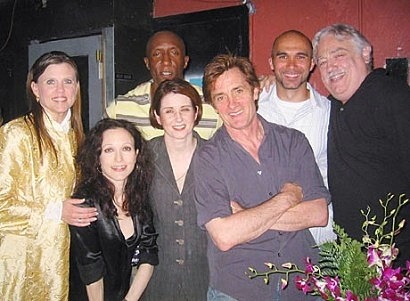
It was even further an important show to her, because it was “a very private thing.” She’d describe Jenny as a very physical and emotional role – “the most personal of anything I've done.”
It clearly holds a special place in Bebe’s own heart. Undoubtedly, it would be poignant to revisit again. As we look to the near future of theatre with shows that could feasibly be staged as events start coming back, in tandem with the publicly expressed desire of people wanting to see Bebe back on stage again, this pre-existing, modestly-sized, inventive piece would be no bad suggestion.
How about a Here Lies Jenny reprise when theatre returns?
#bebe neuwirth#here lies jenny#broadway#off broadway#theatre#theater#new york#kurt weill#composer#ann reinking#roger rees#leslie stifelman#chicago the musical#fosse#bob fosse#musical theatre#musical theatre history#theatre history#cabaret#revue#germany#lotte lenya#betty buckley#donna murphy#julie andrews#patti lupone#berlin#stephen sondheim#bernadette peters#bertold brecht
42 notes
·
View notes
Text
SUMMARY The story centers on Diana “Sugar” Hill (Bey), a photographer in Houston whose boyfriend, nightclub owner Langston (Larry D. Johnson), has been killed by mob boss Morgan (Robert Quarry) and his men when he refused to sell the club to Morgan. Sugar seeks the help of a former voodoo queen named Mama Maitresse (Zara Cully) to take revenge on Morgan and his thugs. Mama summons the voodoo lord of the dead, Baron Samedi (Don Pedro Colley), who enlists his army of zombies to destroy the men who killed Langston and now want the club. Investigating the killings is Sugar’s former boyfriend, police Lt. Valentine (Richard Lawson).
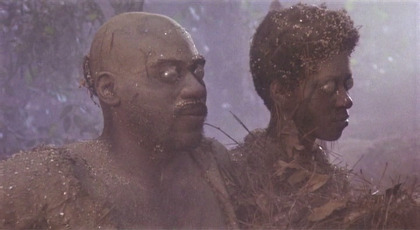
DEVELOPMENT/PRODUCTION The film, budgeted at $350,000, was shot on location in Houston at such locations as the Heights branch of the Houston Public Library (a historical landmark), used in the film as a “Voodoo Institute”. Sugar Hill was the last film Quarry did for AIP, after a run that included the Count Yorga movies. Also appearing in the film was Cully, who played Mama Jefferson on the TV show The Jeffersons. Charles P. Robinson, known for his role as Mac Robinson on NBC’s Night Court, portrayed the character of Fabulous. Hank Edds created the makeup effects for the zombies in the film.

Actress Marki Bey “researched her part among various voodoo cults in and around the L.A. environs; thereby acquiring the proper authoritative menace to make her role as a voodoo high priestess believable.”
Rumor has it that the afro-style hairdo worn by the character Diana Hill during the zombie attack sequences was because Marki Bey didn’t look “black enough” while wearing her hair flat and relaxed.
This slideshow requires JavaScript.
Actor Don Pedro Colley also did extensive research in the voodoo practices from Haiti for his role as Baron Samedi. According to Colley, “This character was based more or less on the actual voodoo character that comes from Haiti…Papa Legre, who is all powerful, all omnipotent. Throughout the voodoo culture Papa Legre is the one single heavyweight dude.”

I’m supposed to be playing a voodoo god rising from the grave with an army of zombies. So I said, “Well, let me go back into my old theater bag of tricks here and do what I’m supposed to do. Let me do a lot of research.’ So I got several books from the library. One was written by two anthropologists that had studied voodoo religions around the world and another was written by a practitioner of voodoo from Haiti. This character was based more or less on the actual voodoo character that comes from Haiti. The Haitian characters name is Papa Legre, who is all powerful, all omnipotent. Throughout the voodoo culture Papa Legre is the one single heavyweight dude. My character’s name was Baron Samedi. It went through how the rituals of voodoo work. For those who believe in it, things can actually happen, good or bad. A woman hates her old man so she goes through a voodoo priestess who puts a hex on him and he ends up dying of a horrible disease or a heart attack or a car crash. By filling a glass with alcohol and burning chicken feathers and spiders and lighting incense and doing chants on a daily basis. The two scientists related voodoo rituals to others rituals that take place in other religions, such as the Catholic religion, the burning of the incense, the drinking of the blood, the wafer, the bread of God. These are rituals that are really taken right out of voodoo rituals. And relating the singing from the Baptist or Episcopalian or Presbyterian religions, even the Muslims and the Sikhs, all of the rituals all had a basis in the early African voodoo tribal religion that came west from the tribes of Africa when the slaves were brought. So I said, ‘I’ve now got all this information. I’m going to make Baron Samedi scary, boy is he going to be scary.””

Robert Quarry reflects on making “Sugar Hill”. The producer and the director Paul Maslansky were both white, and, of course, it was an all-black movie. They had a black actor set for the part, but they got rid of him, and Sam sent me in to take the part. So I walked in as ‘Mr. Whitey’ to play the head of the Mafia in Houston, which is where they shot it. I didn’t give a shit. They paid me. And during the shoot, my rich white friends in Houston wouldn’t call me because they thought I’d bring somebody black to lunch with me. The racism was that subtle. And, of course, they hired so many blacks for the movie, and here I was saying things like ‘nigger’ and ‘jig’ and ‘jungle bunny.’ The extras who weren’t actors were going to kill me because they thought I was a big racist. But I won them over eventually. And we all laughed so hard. I’d tell them all on the set, ‘Okay, easy fellas, get ready because I’m going to say the ‘n’ word again.” One of the locations was this mansion that looked like it had been abandoned for a hundred years. It even had an elevator in it. It had been abandoned for ten or fifteen years. The place was full of cobwebs and dust, it was really quite neat. The only thing I objected to is, here I am starring in this movie and I’m being treated like a peon. Here they are paying me 750 dollars a week and I’m starring in this bloody mess. Union law states that when the performers travel, they travel first class and they stay in a first class hotel and when they work on the set they have a first class dressing room. In Houston, I didn’t have any dressing room. It was like 95% humidity. It was 95 degrees every day. They were talking about having me stand behind a car in the street to change clothes. Forget it! So I went out and rented a forty foot motor home and I drove it to the set and the producer went bugo, he went off – ‘You can’t do that! You can’t drive that here! We have to put a union driver on that. We have to pay the union drivers a thousand a week and…’ And I said, ‘Wait a minute. Are you telling me that a driver of my motor home makes more money a week than I do and I’m starring in this piece of shit!?” I said, ‘I’m going to keep this until you provide me with a dressing room and in the mean time I’m calling the union and letting them know exactly what you people are doing down here.’ That’s what they did at American International. They exploited everybody.
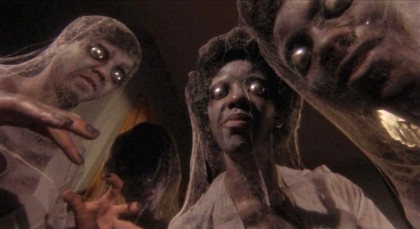
The performers playing the zombies in Sugar Hill wore ping pong balls cut in half over their eyes, creating the cartoonish, yet eerie effect. Other sources say the eyes were created with broken-off spoon halves.
This slideshow requires JavaScript.
SCORE/SOUNDTRACK
youtube
Supernatural Voodoo Woman Written by Dino Fekaris & Nick Zesses Sung by The Originals
CAST/CREW Directed Paul Maslansky
Produced Elliot Schick
Written Tim Kelly
Marki Bey as Diana Hill Robert Quarry as Morgan Don Pedro Colley as Baron Samedi Betty Anne Rees as Celeste Richard Lawson as Valentine Zara Cully as Mama Maitresse Charles P. Robinson as Fabulous Larry D. Johnson as Langston Rick Hagood as Tank Watson Ed Geldart as O’Brien Albert J. Baker as George Raymond E. Simpson, III as King Thomas C. Carroll as Baker Big Walter Price as Preacher
CREDITS/REFERENCES/SOURCES/BIBLIOGRAPHY Fangoria#64 Psychotronic Video#31 Psychotronic Video#33 TCM
Sugar Hill (1974) Retrospective SUMMARY The story centers on Diana "Sugar" Hill (Bey), a photographer in Houston whose boyfriend, nightclub owner Langston (Larry D.
2 notes
·
View notes
Note
Alon ggv the line of the masc names with a lot of possible nicknames, can I have some feminine names too?
Surely!
Elizabeth - Ellie, El, E, Eliza, Liza, Liz, Lizzie, Beth, Betty
Katherine - Kay, Kate, Kath, Kathy, Katie, Kat
Christina - Chris, Chrissy, Christy, Tina, C, C+middle initial
Josephine - Jo, Joey, Joss, Josie, Seph
Annabelle - Ann, Annie, Anna, Belle, Elle, Ellie
Isabella - Iz, Izzie, Isa, Isabelle, Belle, Bella, Ellia
Matilda - Mat, Mattie, Millie, Til, Tilda, Tilly, M
Margaret - M, Meg, Mag, Maggie, Margo, Marge, Peg, Peggy
Patricia - Pat, Patty, Trish, Tricia, Tish, Tisha
Rebecca - Ree, Reba, Becca, Becky, Beck, Becks, Bex
Charlotte - Char, Charlie, Lot, Lottie, Carly, Carrie
4 notes
·
View notes